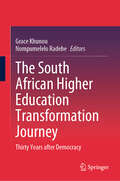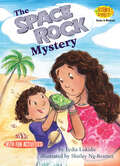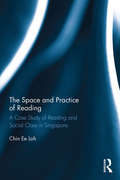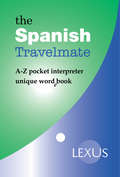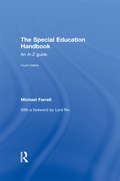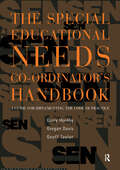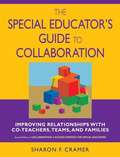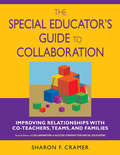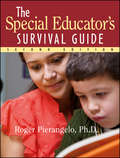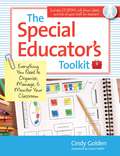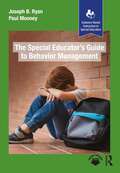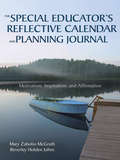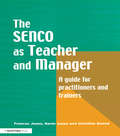- Table View
- List View
The South
by B. C. HallA tour through the history, politics, and culture of the South is complemented by interviews with such figures as William Fulbright, Daisy Bates, Rosa Parks, Jimmy Buffett, and Shelby Foote.
The South African Higher Education Transformation Journey: Thirty Years after Democracy
by Grace Khunou Nompumelelo RadebeThis book explores the transformation of the South African higher education system 30 years after democracy. It examines the progress, tensions, and possibilities through a detailed analysis of how inclusion, curriculum transformation, and epistemological shifts have shaped—and continue to shape—South African higher education. The chapters draw on a range of theoretical frameworks, including decolonization, Africanization, and intersectionality. The book argues that while the South African higher education system has made significant strides in expanding access and fostering critical engagement, the journey toward full transformation remains an ongoing endeavor. The conclusions reached in the book suggest that deep inclusion, meaningful curriculum transformation, and epistemic justice require sustained institutional commitment, policy alignment, and active engagement with students, academics, and society at large.
The Sovereignty and Goodness of God (SparkNotes Literature Guide Series)
by SparkNotesThe Sovereignty and Goodness of God (SparkNotes Literature Guide) by Mary Rowlandson Making the reading experience fun! Created by Harvard students for students everywhere, SparkNotes is a new breed of study guide: smarter, better, faster. Geared to what today's students need to know, SparkNotes provides: *Chapter-by-chapter analysis *Explanations of key themes, motifs, and symbols *A review quiz and essay topicsLively and accessible, these guides are perfect for late-night studying and writing papers
The Soviet Secondary School (Routledge Library Editions: Comparative Education #16)
by Dora ShturmanOriginally published in 1988. The Soviet secondary school is an important topic for comparative educationalists and also for political scientists interested in how the Soviet education system shapes the outlook of Soviet children. This book charts developments in the Soviet secondary school, beginning in the prerevolutionary period and coming right up to the present. It shows how the system was radically changed at several different points. The author, who emigrated to Israel from the Kharkov district in 1977, has considerable personal experience of the system as school-girl, teacher, director of studies and headmistress and this experience naturally colours and enriches her analysis.
The Space Rock Mystery: Rocks And Minerals (Science Solves It!)
by Lydia LukidisSolve kid-sized dilemmas and mysteries with SCIENCE SOLVES IT! These fun science books for kids ages 5–8 blend clever stories with real-life science. Why did the dog turn green? Can you control a hiccup? Is that a UFO? Find the answers to these questions and more as kid characters dive into physical, life, and earth sciences. "This rock is totally from outer space!" At least that&’s what Kaleo thinks when he picks up an amazing rock on the beach. Finding out more will lead him and his sister, Leia, on an adventure they&’ll never forget! Books in this perfect STEM series will help kids think like scientists and get ahead in the classroom. Activities and experiments are included in every book!
The Space and Practice of Reading: A Case Study of Reading and Social Class in Singapore (Routledge Research in Language Education)
by Chin Ee LohMirroring worldwide debates on social class, literacy rates, and social change, this study explores the intersection between reading and social class in Singapore, one of the top scorers on the Programme for International Assessment (PISA) tests, and questions the rhetoric of social change that does not take into account local spaces and practices. This comparative study of reading practices in an elite school and a government school in Singapore draws on practice and spatial perspectives to provide critical insight into how taken-for-granted practices and spaces of reading can be in fact unacknowledged spaces of inequity. Acknowledging the role of social class in shaping reading education is a start to reconfiguring current practices and spaces for more effective and equitable reading practices. This book shows how using localized, contextualized approaches sensitive to the home, school, national and global contexts can lead to more targeted policy and practice transformation in the area of reading instruction and intervention. Chapters in the book include: • Becoming a Reader: Home-School Connections• Singaporean Boys Constructing Global Literate Selves: School-Nation Connections• Levelling the Reading Gap: Socio-Spatial Perspectives The book will be relevant to literacy scholars and educators, library science researchers and sociologists interested in the intersection of class and literacy practices in the 21st century.
The Spanish American War (SparkNotes History Notes)
by SparkNotesThe Spanish American War (1898-1901) (SparkNotes History Guide) Making the reading experience fun! SparkNotes History Guides help students strengthen their grasp of history by focusing on individual eras or episodes in U.S. or world history. Breaking history up into digestible lessons, the History Guides make it easier for students to see how events, figures, movements, and trends interrelate. SparkNotes History Guides are perfect for high school and college history classes, for students studying for History AP Test or SAT Subject Tests, and simply as general reference tools.Each note contains a general overview of historical context, a concise summary of events, lists of key people and terms, in-depth summary and analysis with timelines, study questions and suggested essay topics, and a 50-question review quiz.
The Spanish Armada: A Ladybird Expert Book (The Ladybird Expert Series #30)
by Sam WillisPart of the ALL-NEW LADYBIRD EXPERT SERIES.____________Why did the Spanish launch their Armada on England?How did Francis Drake counter the Spanish threat?And why were so many ships lost at sea?In 1585 Spain was the most POWERFUL Empire in the known world.As tensions between PROTESTANT England and CATHOLIC Spain rose . . . SPAIN decided to INVADE ENGLAND. And launched the SPANISH ARMADA This raises the question: how did England manage to overthrow the Spanish invasion? Was it luck or judgement? Discover the answers and more inside Sam Willis's Ladybird Expert - The Spanish Armada, the thrilling and accessible account that explains what happened, who the key figures were and the tactics, triumphs and failures on both sides . . .
The Spanish Travelmate
by Lexus Alicia de Benito Harland Mike HarlandThe Spanish Travelmate phrasebook and dictionary gives you a detailed yet easy-to-use A to Z list of English words and phrases with Spanish translations for quick-find reference. There are more than 3500 words and phrases, and the Spanish translations come together with an easy-to-read pronunciation guide. Tap a hyperlink (there are hundreds of them) to go to special sections: travel tips about being in Spain; basic language notes; typical Spanish replies to your Spanish questions; conversion tables. These are features which make the Travelmate the must-have ebook Spanish phrasebook download for the traveller who wants to really communicate. The Spanish Travelmate phrasebook and dictionary also gives you a detailed Spanish menu reader of over 500 items and a dictionary section with translations of over 300 common Spanish signs and notices. This is the little book that's a big help. And a joined-up language experience.
The Spear: A Novel
by Louis De WohlThis panoramic novel of the last days of Christ ranges from the palaces of imperial Rome to the strife-torn hills of Judea--where the conflict of love and betrayal, revenge and redemption, reaches a mighty climax in the drama of the Crucifixion. For this is the full story of the world's most dramatic execution, as it affected one of its least-known participants--the man who hurled his spear into Christ on the Cross.Among his many successful historical novels, Louis de Wohl considered The Spear the magnum opus of his literary career."Exceptionally powerful...an excellent piece of work!"--Chicago Sun-Times"A brilliant and panoramic picture of the events and personalities surrounding the Crucifixion."--Catholic Messenger"This novel tells from a new and fascinating angle the age-old story of the men and women who were sublimely affected by knowing the Messiah, Jesus Christ...It is a magnificent novel."--Boston Herald"Told with the clarity and vitality one has come to expect from Louis de Wohl, and holds the reader's interest all the way through...Richly drawn, against a background of mighty drama."--Cincinnati Enquirer
The Special Education Handbook: An A-Z Guide
by Michael Farrell'What a terrific resource: comprehensive and current, this Handbook is a vital acquisition for all involved in special education programs. Dr Farrell writes clearly and with a practical flair ... Highly recommended.' – Michael Arthur-Kelly PhD, Associate Professor and Director, Special Education Centre, University of Newcastle, Australia This acclaimed, bestselling and comprehensive guide, now in a fully updated fourth edition, is an essential reference book for anyone involved with special education. All entries have been reviewed to reflect current practice and the book is enriched with extra resources, including references to useful Internet sites. Focusing on current educational frameworks in the United Kingdom and the United States of America, the author has gathered into one A to Z volume a wide range of information essential to good practice in mainstream and special schools. A thematic index helps the reader plot a course through topics of interest. The broad themes and areas covered are: basic terms, ideas and values venues relating to special education, and school organisation roles and responsibilities individual differences among learners with disabilities and disorders curriculum and assessment, resources and technology pedagogy and classroom organisation therapy and care. Presented in a handy quick reference format The Special Education Handbook also provides a coherent account of the complexities of special education, combining a wealth of practical guidance with the latest research findings. This clear and concise Handbook is indispensable for all those involved in special education, including teachers, teaching assistants, parents, administrators and others.
The Special Educational Needs Co-ordinator's Handbook: A Guide for Implementing the Code of Practice
by Geoff Taylor Garry Hornby Gregan DaviesIn September 1994, the Code of Practice on the Identification and Assessment of Special Educational Needs came into force, and with it a major increase in the expectations placed on teachers in mainstream schools, in particular on the SEN coordinators. This handbook discusses the implications for schools and gives practical guidance on how to implement the code effectively. Throughout, the book provides: * Further information, expanding upon that given in the Code * Examples * Ideas for dealing with SEN in schools * Checklists * Proformas for photocopying and direct use in schools The book begins by explaining and expanding on the Code of Practice, setting it in the context of recent developments including the Education Reform Act and OFSTED criteria for evaluating policy and provision for children in SEN. It then goes on to provide guidelines for implementing the Code of Practice at each of the five stages which it specifies and discusses issues which are raised by this. Specific chapters cover: * Identifying and assessing SEN within the school * Liaison with outside specialists * Statementing * Annual reviews * Knowledge needed by classroom teachers of children with SEN * Implications and issues at different stages of the education system * Parental involvement * Future challenges The book will be of particular interest to special needs coordinators, but will also be of value to anyone else working with children with SEN, including class teachers, heads, advisers, governors, educational psychologists and education welfare officers.
The Special Educator's Comprehensive Guide to 301 Diagnostic Tests
by Roger Pierangelo George Giuliani J.D., Psy.D.This important resource is an update of the best-selling book The Special Educator's Resource Guide to 109 Diagnostic Tests. The greatly expanded second edition contains 301 new and enhanced tests, which are vital to understanding assessment in special education. Designed as an easy-to-use, hands-on resource, the book is filled with practical tools, information, and suggestions. Step-by-step, this practical guide explores the various stages of evaluation, interpretation, diagnosis, prescription, and remediation.
The Special Educator's Guide to Collaboration: Improving Relationships With Co-Teachers, Teams and Families (2nd Edition)
by Sharon F. CramerThe book presents case stories from up-to-date research, reflection activities, structured research and interview activities for developing collaboration skills.
The Special Educator's Guide to Collaboration: Improving Relationships With Co-Teachers, Teams, and Families
by Sharon F. CramerFind case stories from up-to-date research, reflection activities, structured research and interview activities for developing collaboration skills.
The Special Educator's Survival Guide
by Roger PierangeloWritten for educators who work with special children and teens, this second edition of a best-selling classic offers a practical guide to every facet of the special education teacher's job, from teaching in a self-contained classroom or resource room to serving on a multidisciplinary team. This easy-to-follow format, takes you step by step through the various stages required to understand the referral process, parent intakes and conferences, evaluation, interpretation, diagnosis, remediation, placement, individual education plans, classroom management, medication, educational law, and more.
The Special Educator's Toolkit: Everything You Need to Organize, Manage, and Monitor Your Classroom
by Cindy Golden Juane HeflinOverwhelmed special educators: Reduce your stress and support student success with this practical toolkit for whole-classroom organization. A lifesaver for special educators in any Ka 12 setting, this book-and-CD set will help teachers expertly manage everything, from schedules and paperwork to student supports and behavior plans. Cindy Golden, a seasoned special educator, administrator, and psychologist with almost 30 years of experience, has based this teacher-friendly toolkit on her popular OMAC (Organization and Management of All Classrooms) system--an innovative approach to creating effective classrooms for students with all types of disabilities. Special educators will get step-by-step, ready-to-use guidance on managing six key aspects of their daily work: Environment. Make the most of every inch of classroom space Clean out clutter, arrange furniture to improve traffic flow, and construct classroom zones, work stations, and bulletin board displays that support learning. Communication. Implement low-cost communication supports that meet student needs. Make simple picture symbol books, interactive schedules, labels for classroom areas and objects, and more. Teaching Methods and Materials. Determine student needs, create schedules, simplify the IEP process, and pinpoint the best methods for teaching academic, vocational, behavioral, social, and life skills. Behavioral Systems. Organize a successful behavioral system that motivates students, helps them improve behavior and social skills, and uses positive reinforcement techniques. Data and Paperwork. Learn the secrets to creating a simple, logical, highly efficient system for managing paperworka so more time can be spent on teaching. Staff and Home Supports. Build trusting, respectful relationships with classroom staff and parents with stress-free strategies like team meetings and home communication notebooks. For each of these critical areas, special educators will discover dozens of proven strategies, vivid examples, and clever tips and tricks to help them make immediate improvements in their classroom. They'll also get a CD-ROM with more than 60 printable forms and tools they can use right away to support learning, safety, and positive behavior. This is the ultimate guide for every special educator, from the first-year teacher setting up a new classroom to the seasoned veteran who wants a down-to-earth guide to current best practices. Teachers will come away empowered and motivated to get and stay organized--and they'll see the positive results year after year in their classrooms. CD-ROM includes more than 60 printable forms and tools, including Personal Classroom AssessmentClutter Cleaning ChecklistEnvironmental Planning WorksheetCards for Calming DownLunch Visual Schedule PlacematClass Schedule BookletClassroom Expectations ChartFunctional Behavior AssessmentStudent Safety PlanGroup Lesson PlansIndividual Student Lesson PlanIEP and Eligibility CalendarHome and Staff Supports ChecklistHomea School Notesand more "
The Special Educator’s Guide to Behavior Management (Evidence-Based Instruction in Special Education)
by Paul Mooney Joseph B. RyanThis accessible, practitioner-focused textbook details a comprehensive classroom behavior management framework that is easy to understand and implement within a K-12 classroom. Influenced by decades of classroom teaching and special education teacher candidate preparation experiences, the book features effective evidence-based strategies designed to both prevent problem behaviors from occurring in classrooms and address challenging behaviors that presently exist or may arise.Each of the book’s four sections show readers step-by-step how to develop, implement, and evaluate a personalized behavior management plan that best meets the unique needs of their classrooms which can vary tremendously in both size and types of students served. From the first page to the last, this new text addresses the reader in a friendly, personal way in an effort to enhance accessibility and encourage them to want to understand the "what and how" of each strategy and/or process and how it relates to the overall behavioral framework laid out in section one.Ideal for both current and prospective special educators, this book supports readers in developing their own comprehensive approach to classroom behavior management that can be implemented across grade levels.
The Special Educator’s Reflective Calendar and Planning Journal: Motivation, Inspiration, and Affirmation
by Beverley H. Johns Mary Zabolio McgrathSpecial educators can go from August to July with this resource's tips, space for daily to-do lists, and reflective prompts on collaboration, working with parents, writing IEPs, and more.
The Special Educator′s Guide to Assessment: A Comprehensive Overview by IDEA Disability Category
by Tara S. Guerriero Mary A Houser Vicki A. McGinleySpecial education students often learn about the characteristics of disabilities, but can lack an understanding of the relationship between diagnostic assessment and eligibility for special education services. The Special Educator′s Guide to Assessment: A Comprehensive Overview by IDEA Disability Category focuses on the role that assessment plays in the diagnosis of a disability, determination of eligibility for special education services, and education of students with disabilities to provide a meaningful interconnection between assessment concepts and classroom application for teachers. Authors Tara S. Guerriero, Mary A. Houser, and Vicki A. McGinley want to ensure that future special education teachers have the preparation to provide comprehensive instruction to P-12 students through this text. While special education teachers are often not the ones conducting comprehensive evaluations, it is paramount that they understand their students’ individual characteristics, and understand how assessment is used to determine diagnosis and eligibility. Framing the text around The Individuals with Disabilities Act (IDEA) provides students with concrete standards by which all disabilities are evaluated and regulated in our public educational system. Part I introduces the basic topics of assessment, ethics, and assessment types. Part II moves on to provide diagnostic and eligibility criteria according to IDEA categories that are most commonly diagnosed in an educational setting while Part III describes the criteria for IDEA categories most commonly diagnosed in a medical setting. Features like case studies and sample comprehensive evaluations help bring to life assessment and how it applies in real classrooms. Included with this title: The password-protected Instructor Resource Site (formally known as SAGE Edge) offers access to all text-specific resources, including a test bank and editable, chapter-specific PowerPoint® slides.
The Special Educator′s Guide to Assessment: A Comprehensive Overview by IDEA Disability Category
by Tara S. Guerriero Mary A Houser Vicki A. McGinleySpecial education students often learn about the characteristics of disabilities, but can lack an understanding of the relationship between diagnostic assessment and eligibility for special education services. The Special Educator′s Guide to Assessment: A Comprehensive Overview by IDEA Disability Category focuses on the role that assessment plays in the diagnosis of a disability, determination of eligibility for special education services, and education of students with disabilities to provide a meaningful interconnection between assessment concepts and classroom application for teachers. Authors Tara S. Guerriero, Mary A. Houser, and Vicki A. McGinley want to ensure that future special education teachers have the preparation to provide comprehensive instruction to P-12 students through this text. While special education teachers are often not the ones conducting comprehensive evaluations, it is paramount that they understand their students’ individual characteristics, and understand how assessment is used to determine diagnosis and eligibility. Framing the text around The Individuals with Disabilities Act (IDEA) provides students with concrete standards by which all disabilities are evaluated and regulated in our public educational system. Part I introduces the basic topics of assessment, ethics, and assessment types. Part II moves on to provide diagnostic and eligibility criteria according to IDEA categories that are most commonly diagnosed in an educational setting while Part III describes the criteria for IDEA categories most commonly diagnosed in a medical setting. Features like case studies and sample comprehensive evaluations help bring to life assessment and how it applies in real classrooms. Included with this title: The password-protected Instructor Resource Site (formally known as SAGE Edge) offers access to all text-specific resources, including a test bank and editable, chapter-specific PowerPoint® slides.
The Special Needs Coordinator as Teacher and Manager: A Guide for Practitioners and Trainers
by Kevin Jones Frances Jones Christine SzwedThis text reflects the shift in the SENCO's role from SEN teacher to manager. Written within the context of the most recent government initiatives, it can be used by both special-needs coordinators and by special-educational-needs trainers and advisory staff. In two parts, it explores the range of skills required for the role of special needs coordinator and offers information and advice to develop those skills. Practical activities enable the user to monitor and evaluate special-needs provision in their own school and to implement a structured process of change in partnership with all those involved in meeting special educational needs.
The Special School's Handbook: Key Issues for All (nasen spotlight)
by Michael FarrellGiving an up-to-date picture of the work of special schools, this practical and informative book provides an invaluable and timely companion for anyone teaching or planning to teach in special schools in the United Kingdom. Using case studies of good practice to provide clear suggestions on how special schools may be further developed, the wide-ranging chapters address topics such as: adapting the curriculum to give special schools more flexibility implications of Every Child Matters and multi-professional working organisational changes in special schools the changing roles of staff in the modern special school ways of assessing the progress and achievement of pupils working with parents. With a no-nonsense, non-academic approach, and with each chapter featuring think points and suggestion for further study, The Special School's Handbook contains a wealth of invaluable information, resources and advice and is a handy reference book which staff can dip in and out of at their leisure.
The Spectrum of Sport Coaching Styles
by Shane Pill Brendan SueSee Mitch Hewitt Joss RankinFor the first time, this book applies The Spectrum to sports coaching to become a Spectrum of Coaching Styles. The non-versus approach to pedagogy taken by The Spectrum places athletes or players at the centre of their learning and clearly defines who (player or coach) is making pedagogical decisions in each style. This clarity allows players and coaches to have their teaching behaviours and decision-making clearly defined, and it provides a common language for players, coaches and practitioners to talk about coaching styles and the expected outcomes. For coaches interested in the holistic development of the player/athlete, The Spectrum provides a detailed framework for achieving multiple learning outcomes through cognitive, social, physical, ethical, emotional and social development. Written by coaches for coaches, this book applies Spectrum theory in a coach-specific/friendly way to the following: Introduction to The Spectrum and the sport coach as educator; Summary and detailed description of the 11 coaching styles and their suitability to particular types of coaching episodes; Outlines of the strengths of each style with application examples; and Explanations of coaching to develop reflective practice, self-analysis and error correction, how to coach players to decide on appropriate practice levels or challenge points, player problem solving and solution generation ability. The Spectrum of Sport Coaching Styles is important reading for coaches, athletes, students and lecturers of sports coaching across any sport.
The Spectrum of Sport Coaching Styles
by Shane Pill Brendan SueSee Mitch Hewitt Joss RankinFor the first time, this book applies The Spectrum to sports coaching to become a Spectrum of Coaching Styles. The non-versus approach to pedagogy taken by The Spectrum places athletes or players at the centre of their learning and clearly defines who (player or coach) is making pedagogical decisions in each style. This clarity allows players and coaches to have their teaching behaviours and decision-making clearly defined, and it provides a common language for players, coaches and practitioners to talk about coaching styles and the expected outcomes. For coaches interested in the holistic development of the player/athlete, The Spectrum provides a detailed framework for achieving multiple learning outcomes through cognitive, social, physical, ethical, emotional and social development.Written by coaches for coaches, this book applies Spectrum theory in a coach-specific/friendly way to the following: Introduction to The Spectrum and the sport coach as educator; Summary and detailed description of the 11 coaching styles and their suitability to particular types of coaching episodes; Outlines of the strengths of each style with application examples; and Explanations of coaching to develop reflective practice, self-analysis and error correction, how to coach players to decide on appropriate practice levels or challenge points, player problem solving and solution generation ability. The Spectrum of Sport Coaching Styles is important reading for coaches, athletes, students and lecturers of sports coaching across any sport.

